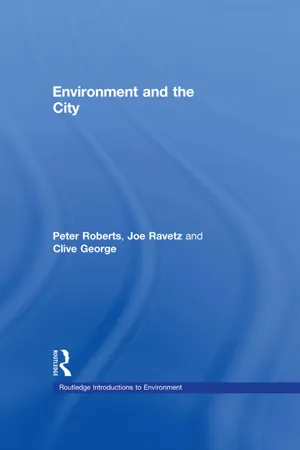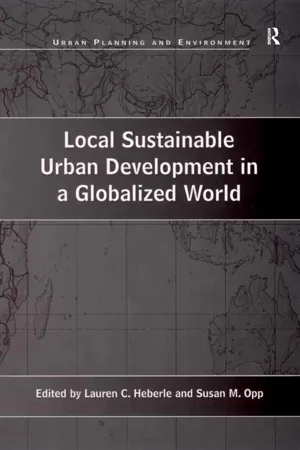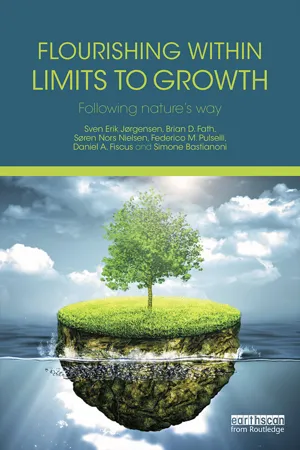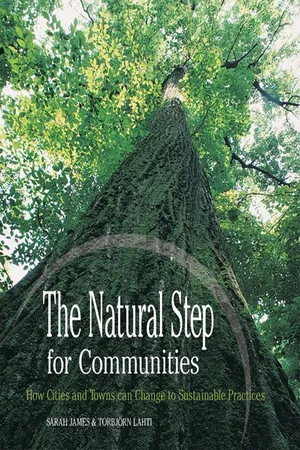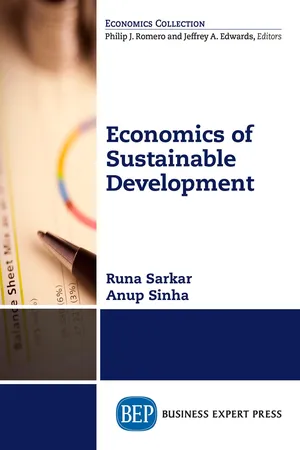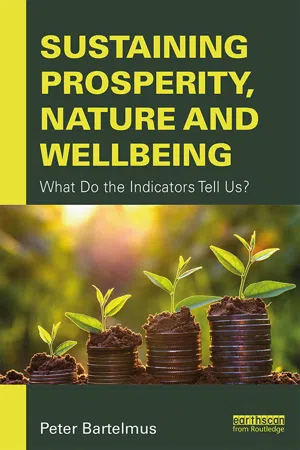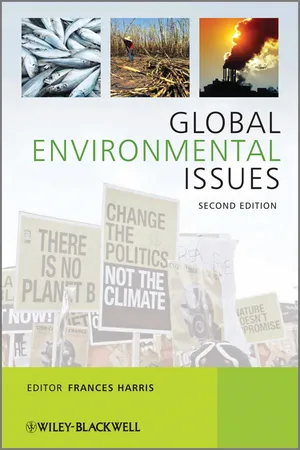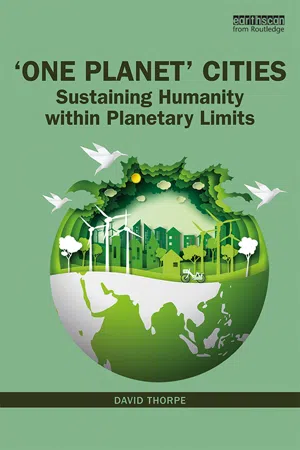Geography
Ecological Footprint of Cities
The ecological footprint of cities refers to the measure of the environmental impact of a city, including its consumption of resources and production of waste. It assesses the amount of land and resources required to support the city's population and activities, highlighting the sustainability challenges faced by urban areas. This concept is crucial for understanding and addressing the environmental implications of urbanization.
Written by Perlego with AI-assistance
Related key terms
Related key terms
1 of 4
Related key terms
1 of 3
11 Key excerpts on "Ecological Footprint of Cities"
- eBook - ePub
- Joe Ravetz, Clive George, Joe Howe, Peter W. Roberts(Authors)
- 2004(Publication Date)
- Routledge(Publisher)
The concept of ecological cycles in environmental science examines how flows of substances, such as water and carbon, continuously circulate through the biosphere. Cities tend to disrupt such natural and self-organising cycles with a ‘linear’ metabolism – natural resources are sucked in, and pollution and wastes are pushed out along with products and services. A city or region which contains its own ecological cycles in a ‘circular metabolism’ would tend to be less vulnerable and damaging, in other words more sustainable. For instance, one key cycle would be food which is locally grown, digested and its nutrients returned to the soil within the hinterland of the city. Even where the cycle is at a global scale, it can still be sustainable, if its side-effects or risks are contained within acceptable limits and thresholds.1.5 Ecological footprintsOne method that can be used to measure and express the quantity and pattern of the consumption of resources by urban areas has been developed through the application of the concept of the ‘ecological footprint’, sometimes called the ‘environmental shadow’. This concept, which allows for a meaningful and comparable measurement of the resources consumed by cities, has been defined as the ‘land required to feed them, to supply them with timber products and to reabsorb their carbon dioxide emissions by areas covered with growing vegetation’ (Smith, et al. , 1998, 20). The ‘ecological footprint’ is a helpful concept because it attempts to measure all the environmental consequences of urban living and consumption in a single consolidated statistic, usually global hectares of land per person. The component parts of the measurement include the direct consumption of energy, food, transport and other resources; the demand made upon land to grow and produce products; and the use made of other areas of land in order to satisfy human needs.Footprints of ‘North’ and ‘South’
Estimates vary of the ‘ecological footprint’ of individual cities, and research is continuing on the differences between urban and rural areas. However, at national level it is evident that the average North American’s ‘ecological footprint’ is five times the world average, and 20 times the ‘ecological footprint’ of the city dwellers in the poorest nations. Box 1.3 - Susan M. Opp, Lauren C. Heberle(Authors)
- 2016(Publication Date)
- Routledge(Publisher)
This chapter is divided into six sections. In the following section we briefly outline the purpose of an Ecological Footprint. The third section notes the adoption of the Ecological Footprint as a sustainability indicator by the National Assembly for Wales and the promotion of the Footprint within Cardiff, the capital city of Wales. The next section outlines the nature of development in Cardiff’s International Sports Village (ISV) – the key development within the city. This is followed by a review of the Cardiff Ecological Footprint and the estimated Footprint of visitors to ISV. Finally, the chapter points out that despite the evidence that the Footprint produces of environmental impact, developmental pressures are likely to remain at the fore.What is an Ecological Footprint?
A Footprint provides a “snapshot” estimate or measure of the area of land and water ecosystems required to provide the resources and to assimilate the wastes of a given population. More simply stated, an Ecological Footprint indicates the demand on the environment for resources. Typically the population studied is that of a nation-state, however the Footprint can also be applied to a region, city (or other administrative area), business, person, or product. Politico-administrative areas are favored units for analysis because they have a defined geographical boundary that can then be compared to the Footprint area. By showing the impact of a population in terms of area, the Footprint provides a clear illustration of the ways in which “… biologically productive land area produces or absorbs flows of many of the materials utilized by our society. Uses are often mutually exclusive and are therefore in competition for the finite area of productive land in the world” (ECOTEC 2001). The Ecological Footprint has the potential to visualize human demands upon the environment in terms of the use of the earth’s available land making it an intuitive and attractive means of measurement.The Ecological Footprint is measured using a standardized area unit equivalent to a world average productive hectare or “global hectare” (gha) and is usually expressed in global hectares per person (gha/capita). It is derived for each study area by estimating the area of land required to support the demand for resources consumed. This demand on nature can be compared with the available Earth’s biocapacity, which translates into an average of 1.8 gha/cap in 2001 (WWF 2004). However, humanity is currently using 2.2 gha/cap which indicates a situation of “overshoot” with nature’s capital being spent faster then it is being regenerated (WWF 2004). Overshoot may permanently reduce the Earth’s ecological capacity.- Stefania Massari, Guido Sonnemann, Fritz Balkau, Stefania Massari, Guido Sonnemann, Fritz Balkau(Authors)
- 2016(Publication Date)
- Routledge(Publisher)
Part IVUsing Life Cycle Approaches at Regional LevelPassage contains an image
24Ecological Footprint
A local policy perspectivePier Paolo Miglietta, Federica De Leo, and Pierluigi TomaIntroduction – Ecological footprint as a policymakers support tool
The ecological footprint measures the biologically productive area needed to sustain a certain human community (Rees 1996; Wackernagel and Rees 1998; Wackernagel and Silverstein 2000) or process (Scotti et al. 2009), as already indicated in Chapter 7 . Because of its intuitive meaning and ease of computation, it has rapidly taken root as a tool for assessing the human pressure on natural resources and ecosystem services. Accordingly, it is perceived as a tool that helps to set up an agenda for local policies. For the ecological footprint to be of help to local administrations, it must produce a reliable picture of what happens in the territory of their jurisdiction, and this includes impacts due to both citizens and production.Local policies aiming at sustainability, in the view of life cycle approaches to sustainable regional development, must thus deal with the latter impacts. The ecological footprint, to be effectively used to monitor progress towards sustainability, must account for the land requirement to sustain local activities.When conducting an ecological footprint analysis, we have to distinguish between the following categories of ecological space (Chambers et al. 2014):- eBook - ePub
Sustainability Economics
An Introduction
- Peter Bartelmus(Author)
- 2012(Publication Date)
- Routledge(Publisher)
Demand is expressed as the ‘area required to produce all the resources an individual, population, or activity consumes, and to absorb the waste they generate’ (Ewing et al. 2010 : 8). Further analysis compares the Footprint to nature’s supply of ‘biocapacity’ or area available for resource use and waste absorption. The result is a measure of ecological deficit, if a nation exceeds nature’s capacity of providing environmental services, or an ecological credit, if it keeps some unused capacity for potential services. The implicit idea is to assess the sustainability of using environmental services, taking limits in their availability into account. Calculations for 2007 present an average of 1.8 ha of biocapacity available per person on earth and an average footprint of 2.7 ha. The world thus faces an ecological deficit of 50 per cent of its biocapacity. Figure 2.2 shows the footprints and resulting ecological deficits or credits for major world regions. Figure 2.2 Ecological Footprint 2007, major world regions. The world exceeded its available biocapacity of 18 billion hectares (1.8 ha per person) by an ecological deficit of over 6 billion ha (0.9 ha per person). The USA generated one of the world's highest footprints of 8 ha per person. Free biocapacity in Oceania and Latin America exceeds the footprint of these regions. Source: Ewing et al. (2010). Table 2.2 presents selected national footprint scores and rankings. The USA is second, surpassed only by the United Arab Emirates, with each person using 8 ha of nature on an average. People in poor countries generate much lower footprints than rich ones. Obviously, the production and consumption levels and techniques of industrialized countries require more natural resource inputs and generate correspondingly higher waste and pollution. Depending on the available biocapacity, the level of footprints does not necessarily correlate with the levels of ecological deficits or credits - eBook - ePub
Flourishing Within Limits to Growth
Following nature's way
- Sven Erik Jørgensen, Brian D. Fath, Søren Nors Nielsen, Federico M. Pulselli, Daniel A. Fiscus, Simone Bastianoni(Authors)
- 2015(Publication Date)
- Routledge(Publisher)
A much more familiar approach is to measure the distance from an ideal state. We can think of many health indicators, such as temperature, blood pressure, cholesterol level, and so on, each with optimal ranges and thresholds. Deviations beyond the optimal ranges indicate we have some sort of illness. The gravity of the illness depends on the distance from the threshold. About sustainability, this means that we can invert the problem and try to understand more about unsustainability as the distance from the ideal of sustainability. Unsustainability becomes a relative concept.In this sense, the Ecological Footprint approach is paradigmatic, comparing the ability of the ecosystems on the biosphere to support human societies (biocapacity) with the actual resource requirement (Ecological Footprint), both expressed in terms of bioproductive land. When the footprint exceeds the biocapacity, there is a deficit, a real measure of unsustainability. Therefore, Ecological Footprint can be seen as a tool able to indicate the minimum criteria for sustainable development (see Note 62 ). Moreover, Ecological Footprint and biocapacity are able to measure the human appropriation of the Earth’s regenerative capacity, which is one key aspect of sustainability. The Earth’s regenerative capacity is thus seen as a limiting factor for the continuation of socioeconomic systems. If the human demand continues to overuse beyond what the biosphere can renew, then the regenerative capacity is threatened. Ecological Footprint is the ecological load imposed on the Earth by humans in spatial terms (see Note 63 ). Rockström and coauthors (2009) propose a framework similar to The Limits to Growth based on “planetary boundaries”; inside this threshold is the safe operating space for humanity (see Notes 63 and 65 ).7.3 The use of resources
One approach to measure whether a system is sustainable consists of investigating the amount and type of resources it uses. A number of approaches exist to aggregate resource use data. Particularly, work energy is an important resource in this context, which will be discussed in the next chapter. The flows of resources feeding a system per unit time, such as material flow accounting and energy accounting, can be used as the basic information. The rationale of the Ecological Footprint analysis and how to use it for assessment of sustainability are presented later. - eBook - ePub
The Natural Step for Communities
How Cities and Towns can Change to Sustainable Practices
- Sarah James, Torbjörn Lahti(Authors)
- 2004(Publication Date)
- New Society Publishers(Publisher)
OurEcological Footprint: Reducing Human Impact On the Earth, New Society Publishers, 1996.Also, Mathis Wackernagel, Chad Monfreda, and Dana Deumling, “Geological Footprint of Nations,” Redefining Progress, November 2002 <www.redefiningprogress.org/publications//ef1999.pdf >8 The concept of a funnel as a metaphor for decreasing resources was introduced by Karl-Henrik Robèrt, John Holberg, et al., The Natural Step, circa 1996.9 Robèrt, op. cit., pp. 64-74.10 EPA (U.S. Environmental Protection Agency), Chemical Information and Data Development, <www.epa.gov/opptintr/chemtest/index.htmwww.epa.gov/opptintr/chemtest/index.htm .>11 Flame retardents in the Arctic: M.G. Ikonomou, S. Rayne, and R.F. Addision, “Exponential Increases of the Brominated Flame Retardants, Polybrominated Diphenyl Ethers, in the Canadian Arctic from 1981 to 2000,” Environmental Science and Technology, 36, pp.1886-1892.12 J. Onstot, R. Ayling, and J. Stanley, “Characterizations of HRGC/MS Unidentified Peaks from the Analysis of Human Adipose Tissue”, Volume 1: Technical Approach, U.S. EPA Office of Toxic Substances (560/6-87-002a), 1987. As referenced by Joe Thornton, Pandora’s Poison, MIT, 2000, p.43.13 R.S.H.Yang, ed., Toxicology of Chemical Mixtures, New York: Academic Press, 1994, pp.99-117. As referenced by Joe Thornton, Pandora’s Poison, MIT, 2000, p. 83.14 Joe Thornton, op. cit., p. 83. Based upon R.S.H.Yang’s asssertion that the number of experiments required to investigate the effects of all possible combinations of N chemicals is always 2 to the N–1 .15 - eBook - ePub
- Runa Sarkar, Anup Sinha(Authors)
- 2017(Publication Date)
- Business Expert Press(Publisher)
Percentagethat ecological footprint exceeds biocapacityJapan5300.7112600China3.4520.9101260South Africa3.3551.293190India1.2260.5136160United States8.233.825120Source: http://footprintnetwork.org/content/documents/ecological_footprint_nations/Box 6.3 Trends in biocapacityIt is expected that more than 80 percent of the world’s population will live in cities by 2050. Thus, urban design will play a pivotal role in reducing ecological footprint, which could be interpreted as a demand on the ecological services from the city. Biocapacity, which represents the supply of ecological services, can be enhanced in an urban area if urbanization is made compact and dense so as to free-up biologically productive land, which when left unharvested, can act as an ecological sink.The future of world cities will determine to a large extent the success of sustainability efforts to contain the planetary ecological footprint. Better technologies and urban planning, now collectively known as the smart city concept, can reduce the ecological footprint while making cities more liveable at the same time. Many of these initiatives revolve around increasing the population density of urban areas while improving the public transportation options. A 100 people per square mile increase in population density is associated with a 0.06 gha per capita decrease in the ecological footprint. As urban infrastructure is long lasting and influences resource needs for decades to come, infrastructure decisions make or break a city’s future.However, on the flipside, improvement in urban amenities is also correlated with increasing affluence of its population, and hence increased consumption expenditure. It has been found that a 1,000 dollar increase in expenditure, on average, correlates with a 0.09 gha per capita increase in ecological footprint. - Ji?í Jaromír Klemeš(Author)
- 2015(Publication Date)
- Butterworth-Heinemann(Publisher)
For groundwater, this is the seepage rate (given by local precipitation). For emissions into the air, the natural exchange of substances between forests and air per unit area is taken as a basis of comparison between natural and anthropogenic flows. Different emissions to air are not weighted, because only the largest dissipation areas are to be considered. Lower area consumption emissions may be dissipated without violating the principle that anthropogenic mass flows must not alter the qualities of local compartments (Sandholzer and Narodoslawsky, 2007). Human footprint The human footprint measures energy quantities, resources, and products consumed by a human during his/her lifetime and includes, for example, the number of food “pieces,” the volumes of fuel and water, and the mass of waste (National Geographic, 2014b). Human footprint evaluates everything humans eat, use, wear, buy, and discard during their lifetime (Kirk, 2011). Human footprint is also a measure of transformation, integrating information regarding human access, settlement, transformation of land use/land cover, and development of energy infrastructure (Trombulak et al., 2010). Waste footprint Waste footprint is the amount of waste produced by sourcing ingredients and materials, manufacturing and processing, and transportation (Thinking Ahead, 2011). It also represent the environmental, economic, and social impacts that result from waste that humans create (HEC Global Learning Centre, 2009). Emergy footprint Emergy footprint combines the EF calculation and emergy analysis (Zhao et al., 2005)- eBook - ePub
Sustaining Prosperity, Nature and Wellbeing
What do the Indicators Tell Us?
- Peter Bartelmus(Author)
- 2018(Publication Date)
- Routledge(Publisher)
Section 7.3 narrows down the notion of ecological sustainability to maintaining at least nature’s source and sink services to the economy; it treats nature as a type of capital used in the production of goods and services. The price of this practical simplification is restricting ecological sustainability to the support of economic activities and their objectives.7.1 Transgression of biocapacity
Biocapacity is about the availability of nature’s benefits. The assumption of measuring ecological sustainability is that this capacity can be measured, linked to its uses and monitored over a lengthy period of time in the past. Models could extend past trends into the future.7.1.1 The Ecological Footprint
The footprint calculations are the only attempt at recurrently confronting biocapacity with increasing demand for environmental services at sub-national, national and global levels. The question is, when does an ecological deficit turn into ecological non-sustainability? The ecological deficit of a region can be misleading as one does not know if and when excessive demand for environmental services will be met by regeneration, importing source and sink services, or reducing and replacing the use of exhaustible natural assets. Figure 7.1 indicates that we might need about half a planet’s additional biocapacity to compensate for an annual ecological overshoot. In other words it would take one-and-a-half years to meet the current annual demand for nature’s services. This may indeed lead to depletion and degradation of the environment.FIGURE 7.1 Ecological Footprint trend. With business as usual and continuing population growth, we might need one more planet in the 2030s and two more in the 2070s to maintain our lifestyles during one year. This looks indeed like non-sustainability of our current needs and wants for the next decadesSource: Bartelmus (2013), with permission from the Taylor & Francis Group.Notes Data source until 2050: World Wide Fund for Nature et al. (2010); two- and three-planets trend: own linear extrapolation.Future environmental impacts and sustainability need to be modeled. Figure 7.1 - eBook - ePub
- Frances Harris, Frances Harris(Authors)
- 2012(Publication Date)
- Wiley(Publisher)
Although a significant portion of humanity's impact on the global environment originates in urban areas, there are also opportunities to mitigate and adapt to global environmental change through urban processes. There has been much research progress over the last decade and the field of urbanization and global environmental change is still relatively young. We are just beginning to unravel the complexities of these relationships. One thing is clear: urbanization is central to global environmental change and as such will necessarily be integral to a transition towards sustainability.(Seto and Satterthwaite, 2010, p. 128) 9.6 ConclusionThis chapter has set out to briefly review approaches to the understanding and achievement of sustainable human settlements. The discussion has covered approaches, such as the ecological footprint, which emphasises the importance of understanding that what happens in cities has environmental implications beyond the city limits. It considered the ‘green’ and ‘brown’ agendas: the idea that for some, environmental problems relate to pollution reduction, waste management and making cities more attractive places in which to live, while for others the environment of the city had very real implications in terms of environmental health issues. Having discussed some theoretical approaches, the chapter then examined in a little more depth some key issues to the sustainability of human settlements, including people, hazards, food, water, shelter. In each of these, a number of central issues were discussed and case studies used to illustrate the main points. Finally, the chapter has drawn to a conclusion by arguing that many of the urban utopias that have been put forward, while visionary, have been based on an analysis of the urban environment that is far from universal. More recent developments suggest that the most appropriate way for cities to develop may be very different from city to city, and that it is the urban residents and managers who are best placed to identify the most pressing needs for each city. Considerable incremental progress can be made. This means developing the capacity of the representative groups to negotiate a future that is sustainable, and linking the human process to the ecological processes in the city and regional environment. This implies that the key to sustaining the human settlements of the future is in the partnerships between urban managers and those who live in the cities within a framework of equity, empowerment and consensus. - eBook - ePub
'One Planet' Cities
Sustaining Humanity within Planetary Limits
- David Thorpe(Author)
- 2019(Publication Date)
- Routledge(Publisher)
A related concept is energy intensity. This measures productivity in terms of the quantity or value (of anything) produced, divided by the amount of energy needed to produce it. It is typically measured in the context of fossil fuel-sourced energy rather than renewable energy since the purpose of doing so is to reduce carbon emissions.Countries and industries measure the rate of improvement in their energy efficiency by quantifying their energy intensity. Energy intensity is reduced if more goods and services are produced with less energy. Producing more with less of anything is a way of reducing an ecological footprint. See Chapter 8 on industry for more detail.LEED-ND
The Leadership in Energy and Environmental Design – Neighborhood Development (LEED-ND) certification programme, currently in version four, has been applied to district-scale projects since 2009. It is the leading certification programme of its type in the USA. It is a standard whose indicators are both qualitative and quantitative: smart location, good design, the reduction in vehicle miles travelled by making jobs and services accessible by foot or public transit, green building and green infrastructure, efficient energy and water use, the protection and conservation of habitat, wetlands, water bodies, and prime agricultural lands. Its checklist criteria are acknowledged to be less rigorous than carbon neutrality, but there is a requirement for district-scale projects to reduce energy and material flows. It does not relate directly to absolute biocapacity.Water footprint
The water footprint forms part of the ecological footprint, that is the total volume of freshwater consumed by an individual, community or business to produce goods and services, or produced by a business. It is measured in volume consumed (evaporated) and/or polluted over a given period of time. Methodologies for measuring the water footprint are covered by the standards ISO/TR 14073:2017 and BS EN ISO 14046:2016. It includes a water scarcity index that maps demand onto local supply limits.
Index pages curate the most relevant extracts from our library of academic textbooks. They’ve been created using an in-house natural language model (NLM), each adding context and meaning to key research topics.
Explore more topic indexes
Explore more topic indexes
1 of 6
Explore more topic indexes
1 of 4
